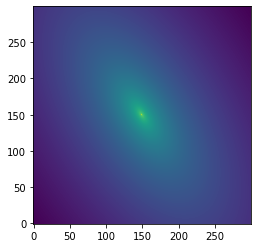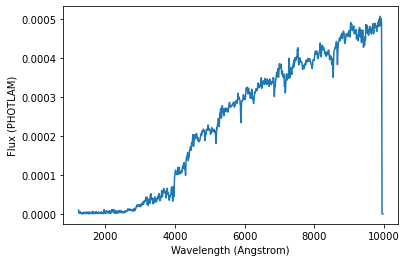Extragalactic¶
A few functions that can also helpt to create extragalactic objects
[1]:
import numpy as np
import matplotlib.pyplot as plt
from scopesim_templates.extragalactic import galaxy
The function galaxy will generate a sersic profile with user provided parameters. The function can accept any sed in the speXtra package.
It must be noted that the pixel scale is not related to the pixel scale of the final simulation but to the pixel scale (in arcsec) of the generated image. It is recommended to be fine enough to well sample the profile of the galaxy.
The SED and the selected filter must overlap but an error will be thrown if they don’t.
[2]:
src = galaxy("kc96/s0", z=0.1, amplitude=17, filter_curve="g", pixel_scale=0.05, r_eff=2.5, n=4, ellip=0.5, theta=45, extend=3)
plt.imshow(np.log10(src.fields[0].data), origin="lower")
[2]:
<matplotlib.image.AxesImage at 0x7f40bb2b6940>

We can also visualize the spectrum
[3]:
sp = src.spectra[0]
sp.plot()

Finally there is much that can be done with the spectrum itself, like for example, obtaining the magnitude in a different filter
[4]:
sp.get_magnitude(filter_curve="u", system_name="AB")
[4]:
$18.848014 \; \mathrm{mag}$$\mathrm{\left( \mathrm{AB} \right)}$
More can be found in the speXtra package.